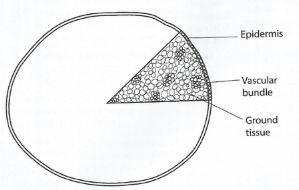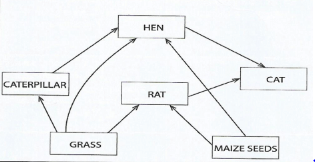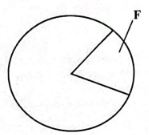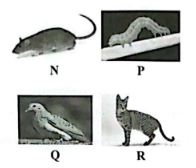QUESTIONS;
- You are provided with the following material and apparatus:
- A prepared slide, labelled E containing the transverse section through a plant organ.
- Access to a light microscope with at least the low and medium power objective lens.
- Observe the section under the low power and medium power objective lens of the light microscope.
- Fill the portion, labelled F in the plan diagram below to show (a portion of) the structures seen under the medium power objective of the light microscope. Label the structures. (3 marks)
- Calculate the magnification of the image observed under low power objective lens. (2 marks)
- Fill the portion, labelled F in the plan diagram below to show (a portion of) the structures seen under the medium power objective of the light microscope. Label the structures. (3 marks)
- With reference to one observable feature, state the Class of plants from which the organ was obtained. (2 marks)
- Name the plant part from which the section was obtained. (1 mark)
- State two precautions one should take to ensure the safety of the slide during observation under the microscope. (2 marks)
- State how each of the following parts of the light microscope contributed to clarity of the image of the section observed. (3 marks)
- Mirror
- Diaphragm
- Condenser
- Observe the section under the low power and medium power objective lens of the light microscope.
- You are provided with the following materials and reagents.
- Half a portion of raw banana
- 3 beakers labelled G, H and J treated as follows:
- Beaker G contains 50 ml of dilute hydrochloric acid
- Beaker H contains 50 ml of distilled water
- Beaker J is empty
- Scalpel
- Spatula/pair of forceps
- A white plain paper or white tile
- Stopwatch/means of timing
When some plant tissues are exposed, enzymes on the exposed surfaces react with oxygen. Using the provided materials, investigate the enzyme-oxygen reaction using the procedure below.- Slice off about 2 mm from the exposed end of the raw banana and discard the slice.
- Slice another piece, about 1 cm wide from the remaining banana to use in the investigation.
- Divide the portion obtained in (II.) above into three parts (a, b and c) as illustrated in the diagram below.
- Remove the peel from portion a, cut the peel into three pieces and immediately drop all the three pieces into beaker G (containing hydrochloric acid). Obtain peels only, without remnants of banana flesh.
- Repeat procedure IV with peels from portion b into beaker H (containing distilled water) and those from portion e into beaker J.
- Leave the set-up for five minutes and observe the inner surfaces of the banana peels in each beaker.
-
- Record the observations made in each case. (3 marks)
G
H
J - Account for the observations made in beakers H and J.
Beaker H (2 marks)
Beaker J(2 marks)
- Record the observations made in each case. (3 marks)
-
- Using the spatula/pair of forceps provided, remove the peels from each beaker and expose the sets of peels separately on the plain paper/white tile provided. Leave them for a further five minutes and observe.
-
- Record the observations made on the peels from beakers H and J.
H (1 mark)
J (1 mark) - Account for the observations on the surfaces of peels from beakers G and J after a further 5 minutes.
G(1 mark)
J (1 mark)
- Record the observations made on the peels from beakers H and J.
- Suggest the suitable pH for the enzymes found on the surface of the banana peels. (1 mark)
- Suppose the peels in set up J were initially boiled for 5 minutes.
- Suggest the observations that would have been made.(1 mark)
- Explain the observations made in (d)(i). (1 mark)
-
- You are provided with specimens labelled K and L together with photographs of organisms labelled N, P, Q and R.
Assuming the organisms are found in the same ecosystem:-
- Construct a complete food web that includes the specimens and photographs of organisms in this ecosystem. (8 marks)
- From the food web, identify the longest food chain. (2 marks)
-
- Identify the organisms with the highest biomass. (1 mark)
- Give a reason for your answer in (b)(i) above. (1 mark)
- Other than feeding, explain how the organism represented in photograph R benefits from specimen K. (1 mark)
-
MARKING SCHEME
| 1(a)(i) |  Any 2 correct labels Any 2 correct labels |
(3marks) |
| (ii) | Magnification = Lower power objective magnification x eyepiece objective magnification = x4 × x10 = x40; |
(2marks) |
| (b) | Monocotyledonae; Scattered vascuar bundles; |
(2marks) |
| (c) | (Monocotyledonous stem) | (2marks) |
| (d) |
|
(2marks) |
| (e) | (i) Mirror- reflects light onto the stage/slide/ specimen/ into the microscope (ii) Diaphragm - regulates/controls the amount of light falling/ reaching onto the object/stage /slide; (iii) Condenser - concentrates light onto the object/slide/stage/specimen |
(3 marks) |
| 2. (a)(i) |
In
|
(3 marks) |
| (ii) |
|
(2 marks) (2 marks) |
| (b)(i) |
|
(1 mark) (1 mark) |
| (ii) |
|
(1 mark) (1 mark) |
| (c) | Neutral/pH 7.0; | (1 mark) |
| (d)(i) | No colour change/ white/cream/yellow/cream yellow; | (1 mark) |
| (ii) | Boiling denatures/ destroys/ kills enzymes; | (1 mark) |
| 14 marks | ||
| 3(a)(i) |  |
(8 marks) |
| (ii) | Grass/K → Caterpillar/P → Bird/hen/Q → Cat/R Grass/K → Caterpillar/P → Rat/N → Cat/R Maize/L → Caterpillar/P → Rat/N → Cat/R Correct identification of the longest food chain/ organisms in the food chain; Direction of arrows; |
(2 marks) |
| (b)(i) | Grass/ Specimen K/ maize/ Specimen L; | ( 1mark) |
| (ii) | It is a producer/ manufactures own food (directly from the sun); | |
| (c) |
|
(1 mark) |
| (13marks) |
Join our whatsapp group for latest updates
Tap Here to Download for 50/-
Get on WhatsApp for 50/-
Download BIOLOGY Paper 3 Questions and Answers- KCSE 2022 Past Papers.
Tap Here to Download for 50/-
Get on WhatsApp for 50/-
Why download?
- ✔ To read offline at any time.
- ✔ To Print at your convenience
- ✔ Share Easily with Friends / Students



